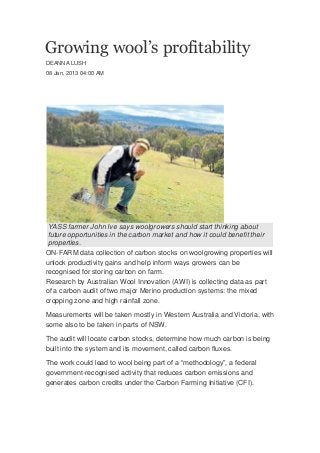
Producción de lana en el flujo de carbono (the land)
- 1. Growing wool’s profitability DEANNA LUSH 08 Jan, 2013 04:00 AM YASS farmer John Ive says woolgrowers should start thinking about future opportunities in the carbon market and how it could benefit their properties. ON-FARM data collection of carbon stocks on woolgrowing properties will unlock productivity gains and help inform ways growers can be recognised for storing carbon on farm. Research by Australian Wool Innovation (AWI) is collecting data as part of a carbon audit of two major Merino production systems: the mixed cropping zone and high rainfall zone. Measurements will be taken mostly in Western Australia and Victoria, with some also to be taken in parts of NSW. The audit will locate carbon stocks, determine how much carbon is being built into the system and its movement, called carbon fluxes. The work could lead to wool being part of a “methodology”, a federal government-recognised activity that reduces carbon emissions and generates carbon credits under the Carbon Farming Initiative (CFI).
- 2. Examples of CFI methodologies include reforestation, forest management and native forest protection; landfill gas recovery; manure management; management of methane from livestock, and soil carbon and biochar. Work is in the second year and due to finish by the end of 2013. Data collection should be complete in six months. AWI program manager environment, climate change and carbon Gus Manatsa said the project’s ultimate aim was to improve production and profitability of woolgrowing systems in a sustainable way. He said the project would also help back-up wool’s claims it was a natural, sustainable fibre, which would inform global markets. “The importance of carbon is that it’s the main foundation of your soil’s production system,” Mr Manatsa said. “If you want your soil to be resilient, you have to build your carbon. If your soil health is good, your pasture system is good.” AWI has recently been admitted to two government committees run by the Department of Climate Change and Energy Efficiency charged with investigating possible livestock methodologies. They involve a steering group that is responsible for looking at practical issues identified in the industry while a working group will look into the hard science.